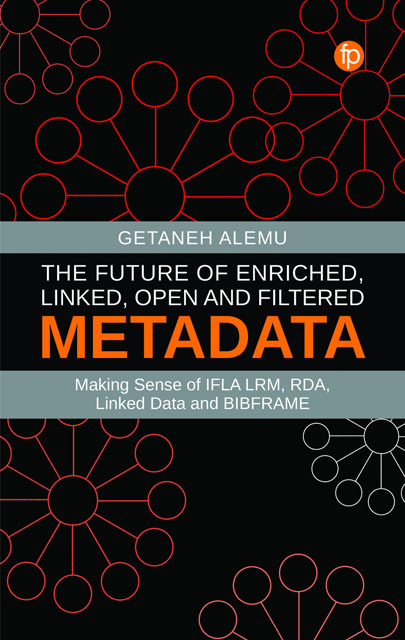 The Future of Enriched, Linked, Open and Filtered Metadata
The Future of Enriched, Linked, Open and Filtered Metadata Published online by Cambridge University Press: 18 November 2022
Overview
The principle of metadata filtering suggests theimportance of reconceptualising current metadatainterfaces from a single expert-filtered andconsistently displayed metadata content descriptionto a contextually relevant, reconfigurable anduser-driven interface. This post-doc filtering isthus both user-led and user-focused, thus betteraddressing users’ diverse needs and requirementsthan traditional (expert-led/single display)interfaces. The principle offers flexibility andfacilitates the serendipitous discovery ofinformation resources. However, in doing so, itshould also be noted that this does not precludefiltering metadata so that only currentstandards-based, objectivist metadata is used andpresented in a standard OPAC, as this may be whatthe users need. Multi-field, stand-alone andnon-web-based Online Public Access Catalogues(OPACs) are complex and outdated (Ballard andBlaine, 2011).
Users prefer web-based and straightforward, integratedinterfaces with facet filters (Ballard and Blaine,2011). As Alemu and Stevens (2015) indicate, ‘Theusers’ preponderance to traverse across informationsources (mediums), supported by triangulatedinformation from disparate sources, necessitatesthat the focus is placed on interlinking ideascontained in various sources such as databases,e-books and e-journals. The freedom of informationfrom its constraining medium through seamlessinterlinking should help users to connect tointer-disciplinary and multi-disciplinary domains ofknowledge. However, this requires a new conceptualapproach to information management.’
User information search behaviours
Bates (1989) argues that users’ search and browsingbehaviours are non-linear, characterised by herberry picking model. Instead, it is iterative,dynamic and evolving. They employ various techniquessuch as searching, browsing, footnote chasing,citation searching, journal run, area scanning,subject searches in bibliographic databases andauthor searching (Bates, 1989). Furthermore, Batesargues that ‘as the sizes and variety of databasesgrow and the power of search interfaces increases,users will more and more expect to be able to searchautomated information stores in ways that arecomfortable and familiar to them’. Wilson'sinformation model (2016) also agrees with thisassessment. Thus, search, and discovery systems needto consider user behaviours and mental models.
Users prefer seamless access to full-text articles andimmediate access to electronic resources (Alemu,2014). In addition, the convenience of access(place), immediacy and currency (up-to-dateness) arevital to them.
To save this book to your Kindle, first ensure no-reply@cambridge.org is added to your Approved Personal Document E-mail List under your Personal Document Settings on the Manage Your Content and Devices page of your Amazon account. Then enter the ‘name’ part of your Kindle email address below. Find out more about saving to your Kindle.
Note you can select to save to either the @free.kindle.com or @kindle.com variations. ‘@free.kindle.com’ emails are free but can only be saved to your device when it is connected to wi-fi. ‘@kindle.com’ emails can be delivered even when you are not connected to wi-fi, but note that service fees apply.
Find out more about the Kindle Personal Document Service.
To save content items to your account, please confirm that you agree to abide by our usage policies. If this is the first time you use this feature, you will be asked to authorise Cambridge Core to connect with your account. Find out more about saving content to Dropbox.
To save content items to your account, please confirm that you agree to abide by our usage policies. If this is the first time you use this feature, you will be asked to authorise Cambridge Core to connect with your account. Find out more about saving content to Google Drive.